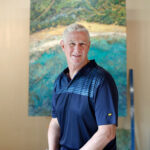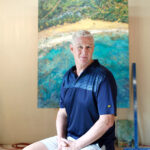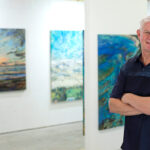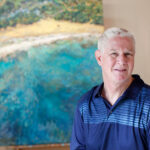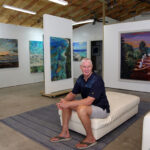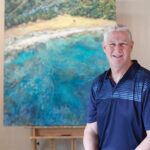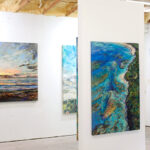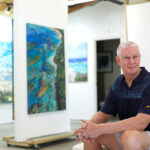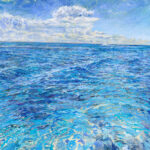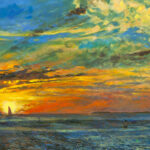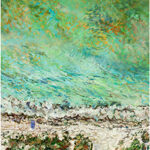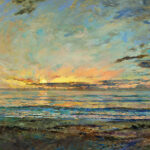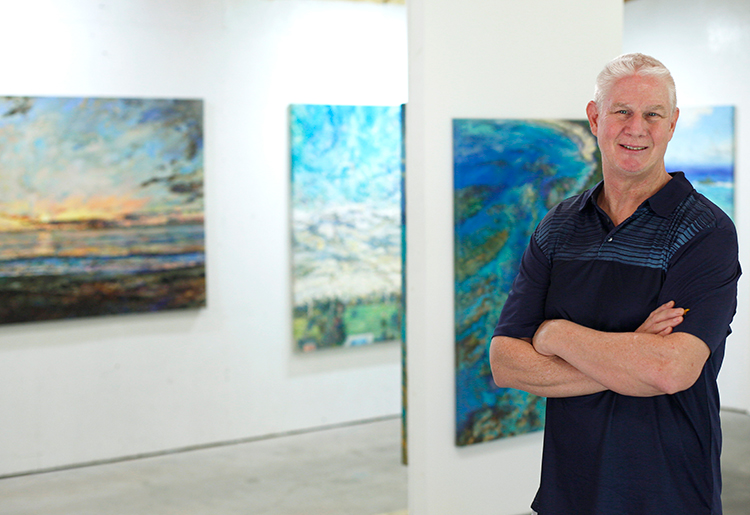
Evan Schwarze says he was blessed with the perfect set of parents, who guided him in ways that would ultimately enable him to always make a living doing what he loves most – art.
He recalls being enrolled in Saturday art classes with his three siblings from the time he was 5 years old. Schwarze also learned to play piano, the cello and the trombone, none of which took hold long term, as he preferred being outdoors.
“We were always enrolled in programs that taught us how to do things. I grew up in a very cultural household,” says Schwarze, adding that his father was an art and music critic, and his mother was an English teacher.
“Growing up in Ohio, we regularly visited the Dayton Art Institute, the Philharmonic Orchestra, and all the ballets and things that went along with my father’s career. My father was a concert pianist,” says Schwarze.
“Up to high school I was still taking the Saturday art classes. Even when my attention turned to sports, my parents forced me to stay with art in high school, encouraging me, seeing an ability in me.”
He received a scholarship to the Columbus College of Art and Design in Ohio, and halfway through realized that art was how he wanted to make a living. He majored in commercial illustration with the intention of moving to the Chicago area.
By then, he says, the creative outlet was very much a part of him, and he realized that he was on the right path.
“I’m a very calm person. I pursue things with a quiet passion,” says Schwarze, describing himself as quietly driven.
“I’m not interested in flamboyance and the image that some creative people have, in part because of my commercial background. [Art] has always been a career, a profession. It’s never been a hobby.”
Schwarze joined a commercial illustration company in Chicago and, as the company and the art world began to evolve into digital formats, he was able to adapt and learn. And while he enjoyed the tangible and fiscal aspects of the job, he was not happy sitting in front of a computer all day.
His clients were high-level ad executives from the corporate world, including Coca Cola, McDonald’s, Disney and Hyatt Hotels.
Schwarze gained the distinction of being one of only 25 people in the world (outside of Disney employees) licensed and qualified to reproduce Disney characters such as Pinocchio and Winnie the Pooh, formatting the figures to the company’s promotional needs. He would do the same with Ronald McDonald, such as placing the character on a surfboard to promote Milk Jugs or Happy Meals.
Schwarze became an independent/freelance artist, preparing artwork for other artists, and later created ads himself, such as for Gatorade. He and his sales rep eventually started their own Art Rep business. He learned the professionalism needed to function in the sales aspect as well as creatively, coping in a harsh and deadline-driven environment without getting flustered.
However, the cutthroat nature of the business and the ups and downs of working either 18-hour days or not at all were beginning to take their toll.
He and wife Stephanie had been renovating a row house outside of Chicago when they decided they were ready for a change. They sold the row house and moved to Culebra, a tiny island [3 miles by 7 miles] just 12 miles west of St. Thomas, and technically part of Puerto Rico.
There, he had a small gallery, and he and Stephanie continued to work digitally in their respective businesses, as reliable Internet connections allowed.
Living in the Caribbean made Schwarze more aware of the horizons in his paintings, pointing out the enormity of the view.
“It is amazing to always see the horizon wherever you look. Capturing that depth of field is most important.”
His aerial paintings began to take shape during this time period, as life on a tiny island meant many short flights to get supplies. Out of these flights for necessities came inspiration, studies and, ultimately, paintings, offering a different perspective and variety to his repertoire.
They lived there for 10 years, but by 2009 the housing market crash made life on Culebra less tenable, so the couple transitioned back to the United States, living in several areas in Florida before zeroing in on Vero Beach in 2018. Logistically, the location was an easy drive to larger towns and cities, making it convenient for art shows, and Stephanie’s work as director of finance at Kimpton Vero Beach Resort and Spa.
“Vero Beach is big enough to get everything you need and small enough to feel small in the good ways,” says Schwarz, appreciating that it is a close-knit, environmentally sensitive community.
“It’s my understanding that Vero Beach has one of the largest and most active land trusts in the country, purchasing things for non-development.”
“My work very much focuses on the natural environment, and Vero has a strong land preservation ethic. We are buffered from so much,” he explains, mentioning the forward-thinking decisions of long ago to limit the height levels of buildings and focus on the natural environment.
“I enjoy being by the water. It’s inspirational, it’s calming and soothing, and the colors of the water are very important to me, [especially] the turquoise and deep blue colors of the Caribbean,” says Schwarze. The ever-present water in his paintings have a sense of depth; the darker areas feel cooler and deeper than the lighter shallow areas, offset by currents sweeping by.
“Capturing the awe of the views as you come over a ridge and see these spectacular images and landscapes and seascapes, and the way we interact with them; my work ultimately is about adventure and inspiration and capturing the awe of the view,” he explains.
“When near the water, you are generally away from the clutter of everyday life. It separates us from responsibilities and gives us a reprieve from that sort of necessity.”
Oftentimes the few manmade objects in his paintings are there simply to set scale to the overall composition of the work, so the viewer can relate to the space and picture themselves within it.
Schwarze says that when starting a new piece, his initial layer is a substantial underpainting of glazes, similar to watercolor techniques, before ultimately adding layer after layer to gain the depth and clarity desired.
“It is important to me to feel as well as see the painting.”
Translucent layers allow light to pass through and bounce back, while the opaque layers bounce light off it in a delicate balance that brings the whole canvas alive.
“It gives levels within a two-dimensional canvas, to achieve depth of field to make it feel real and alive without being photo-realistic,” he explains.
His oil paintings tend to be large, sometimes painted as a diptych for ease of travel, and he generally completes eight to ten originals each year.
“I have found people are drawn to the larger canvases, so I don’t paint many smaller paintings.”
To accommodate a more affordable price range, he also creates embellished giclées, which offer the flexibility of printing smaller or larger versions. All of the prints are then top painted, or embellished to add texture, brushstrokes and color, and are finished in a UV coat of varnish.
Schwarze has participated in the Vero Beach Art Club’s Under the Oaks Fine Art & Craft Show since 2016, as well as a handful of shows throughout Florida. He also shows in a gallery in Coconut Grove, south of Miami.
Photos by Kaila Jones

